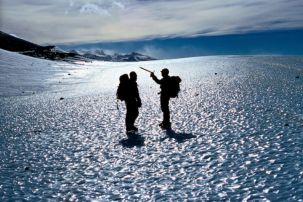Lesson summary
In this activity students investigate what happens when rising temperatures cause ice on land and in the sea to melt. They conduct two experiments, one looking at sea ice and the other looking at land ice and observe how the melting of this ice affects the sea level.
Learning intentions:
Students will...
- understand the difference between sea ice and land ice
- recognise that melting land ice will affect sea levels, but that melting sea ice won’t cause as much of a rise in sea levels
- understand that simple science experiments can be used to demonstrate these differences clearly.
Lesson guides and printables
Curriculum links
Select your curriculum from the options below.
Lesson details
Curriculum mapping
Australian Curriculum content descriptions:
Year 3 Science:
- A change of state between solid and liquid can be caused by adding or removing heat (ACSSU046)
- With guidance, identify questions in familiar contexts that can be investigated scientifically and predict what might happen based on prior knowledge (ACSIS053)
- Compare results with predictions, suggesting possible reasons for findings (ACSIS215)
- Reflect on the investigation, including whether a test was fair or not (ACSIS058)
Year 4 Science:
- With guidance, identify questions in familiar contexts that can be investigated scientifically and predict what might happen based on prior knowledge (ACSIS064)
- Compare results with predictions, suggesting possible reasons for findings (ACSIS216)
- Represent and communicate ideas and findings in a variety of ways such as diagrams, physical representations and simple reports (ACSIS071)
Syllabus Outcomes: ST2-4WS, ST2-12MW.
Time required: 60 mins
Level of teacher scaffolding: High – conduct experiment, facilitate discussion and oversee activity
General capabilities: Critical and creative thinking
Cross-curriculum priority: Sustainability OI.1
Resources required
- Ice cubes
- Waterproof tray
- Plastic sheet
- Sticky tape
- Scissors
- Water
- Black marker
- Ruler long enough to fit most of the width of the tray
- Gravel (optional)
- Internet access
- Student Worksheet
Additional info
This lesson has been created in partnership with WWF-Australia. Earth Hour is the world’s largest community-driven climate change campaign. At the centre of Earth Hour is switching off lights to show a commitment to taking action.
Thousands of teachers use Earth Hour’s education program to enrich their curriculum and provide pathways for young people to create change in their world.
For the most up to date Earth Hour dates, times, and events, check here.


Welcome back!
Don't have an account yet?
Log in with:
Create your free Cool.org account.
Many of our resources are free, with an option to upgrade to Cool+ for premium content.
Already have an account?
Sign up with:
By signing up you accept Cool.org's Terms and Conditions(Opens in new tab) and Privacy Policy(Opens in new tab).